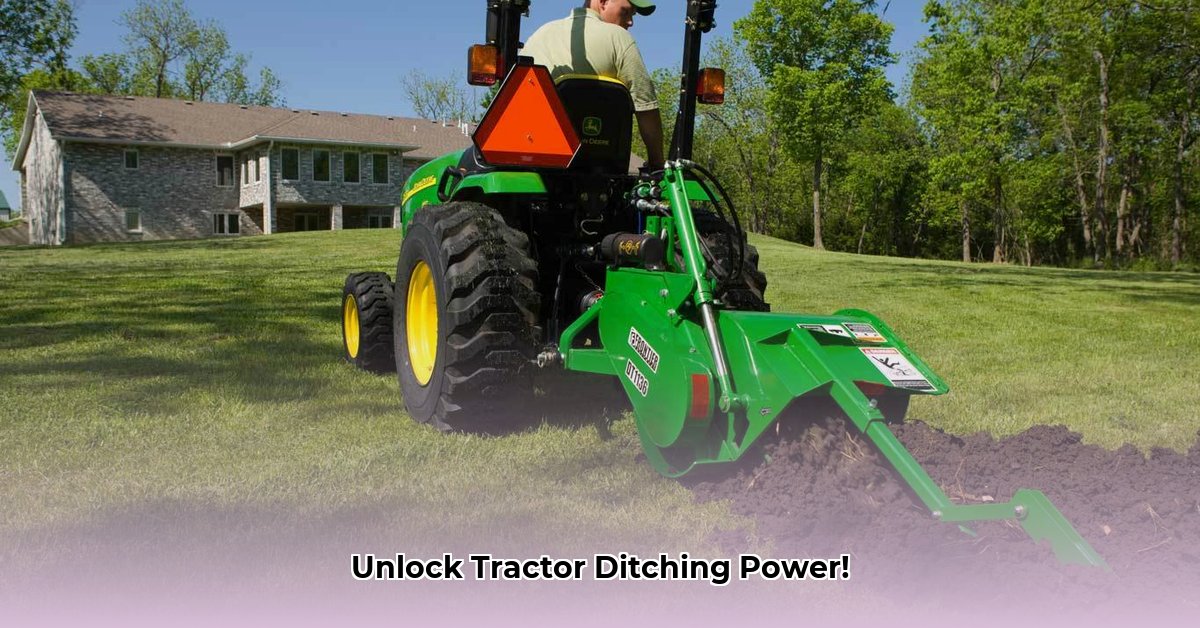
Ditch Attachment for Tractor: Selecting the Optimal Tool
Choosing the right ditching attachment for your tractor is crucial for efficient drainage and improved crop yields. Incorrect selection can lead to wasted time, money, and potential equipment damage. This guide compares two leading brands – AMCO and Hurricane – to help you make an informed decision. For more information on tractor attachments, see this helpful resource: Tractor Attachments Guide.
Why Use a Rotary Ditcher?
Rotary ditchers offer a significant advantage over manual labor or less efficient methods. They create consistent, well-defined ditches quickly, saving valuable time and resources. Improved drainage directly benefits crop health and overall farm productivity. Isn't efficient water management a key factor in maximizing your harvest?
AMCO vs. Hurricane Ditchers: A Comparative Analysis
This section provides a detailed comparison of key features and performance aspects of AMCO and Hurricane rotary ditchers.
| Feature | AMCO Dominator | Hurricane Ditchers (Various Models) | Advantages/Disadvantages |
|---|---|---|---|
| Cutter Head Size | Adjustable 18"-26" | 15", 20", 26", 42" (Offset models available) | AMCO: Less versatility. Hurricane: Greater adaptability to diverse ditching needs and soil conditions. |
| Cutter Head Design | Vertical and Offset | Vertical and Offset | Both offer flexibility; the choice depends on specific ditching requirements and soil type. |
| PTO Horsepower | 80-200 HP | 30 HP - 125 HP | AMCO: Suitable for larger tractors. Hurricane: Compatible with a wider range of tractor sizes, including smaller models. |
| Durability Features | Heavy-duty chains, powder-coated finish | Sealed oil baths, replaceable wear parts | AMCO: Robust construction; Hurricane: Facilitates easier maintenance and component replacement. |
| Additional Features | Ripper shanks (may be included) | Ripper shanks, deflector shields (optional) | Hurricane's modularity allows customization for various tasks. Ripper shanks enhance soil penetration. Deflector shields minimize soil splatter. |
Performance Considerations: AMCO ditchers are renowned for their rugged durability. Hurricane models offer a wider array of sizes, making them suitable for varied terrain and ditch requirements. Soil type significantly impacts performance; harder clay necessitates a more powerful machine than softer, sandy loam. Have you considered the specific demands of your soil type?
Choosing the Right Ditching Attachment: A Step-by-Step Guide
Selecting the appropriate rotary ditcher involves several key criteria:
Tractor Horsepower: Ensure the ditcher's PTO horsepower requirement aligns with your tractor's capabilities. Underpowering will result in inefficiency and potential damage. Always consult your tractor's manual.
Soil Type: Different soil types present unique challenges. Hard clay requires a more powerful machine than sandy loam. Consider renting a ditcher to test it on your soil before purchasing.
Budget: Establish a realistic budget, including purchase, maintenance, and potential repair costs. Explore financing options if needed.
Desired Ditch Dimensions: Determine the required depth and width of your ditches based on drainage needs and expert recommendations (e.g., measuring existing ditches for effective dimensions).
Installation, Operation, and Safety Precautions
Safety First: Before installation, carefully review both your tractor and ditcher manuals. Always wear appropriate safety gear, including hearing protection, safety glasses, and sturdy gloves.
Attachment: Securely connect the ditcher to your tractor's three-point hitch, ensuring all pins and locking mechanisms are properly fastened.
Operation: Begin at a slow speed, gradually increasing as needed. Maintain consistent depth and speed for uniform ditch creation. Never operate in unsafe conditions.
Maintenance and Troubleshooting
Regular maintenance is vital for optimal performance and longevity.
- Lubrication: Keep moving parts well-lubricated.
- Inspection: Regularly inspect for wear and tear on chains and blades. Replace worn components promptly.
- Fluid Checks: Check fluid levels as per the manufacturer’s instructions.
Addressing minor issues quickly prevents them from escalating into major problems.
Common Issues and Solutions:
- Clogged Cutter Head: Reduce speed and depth or consider alternative methods in wet, heavy soils.
- Reduced Cutting Efficiency: Inspect for worn blades and ensure sufficient tractor horsepower.
- Excessive Vibration: Check connections and ensure proper balance.
Conclusion: Optimizing Your Ditching Strategy
Choosing the right rotary ditcher requires careful consideration of several factors. By understanding your soil type, tractor capabilities, budget, and desired ditch dimensions, you can select a tool that enhances your farm's drainage efficiency and overall productivity. Remember: safety and regular maintenance are key to maximizing the lifespan and performance of your investment.